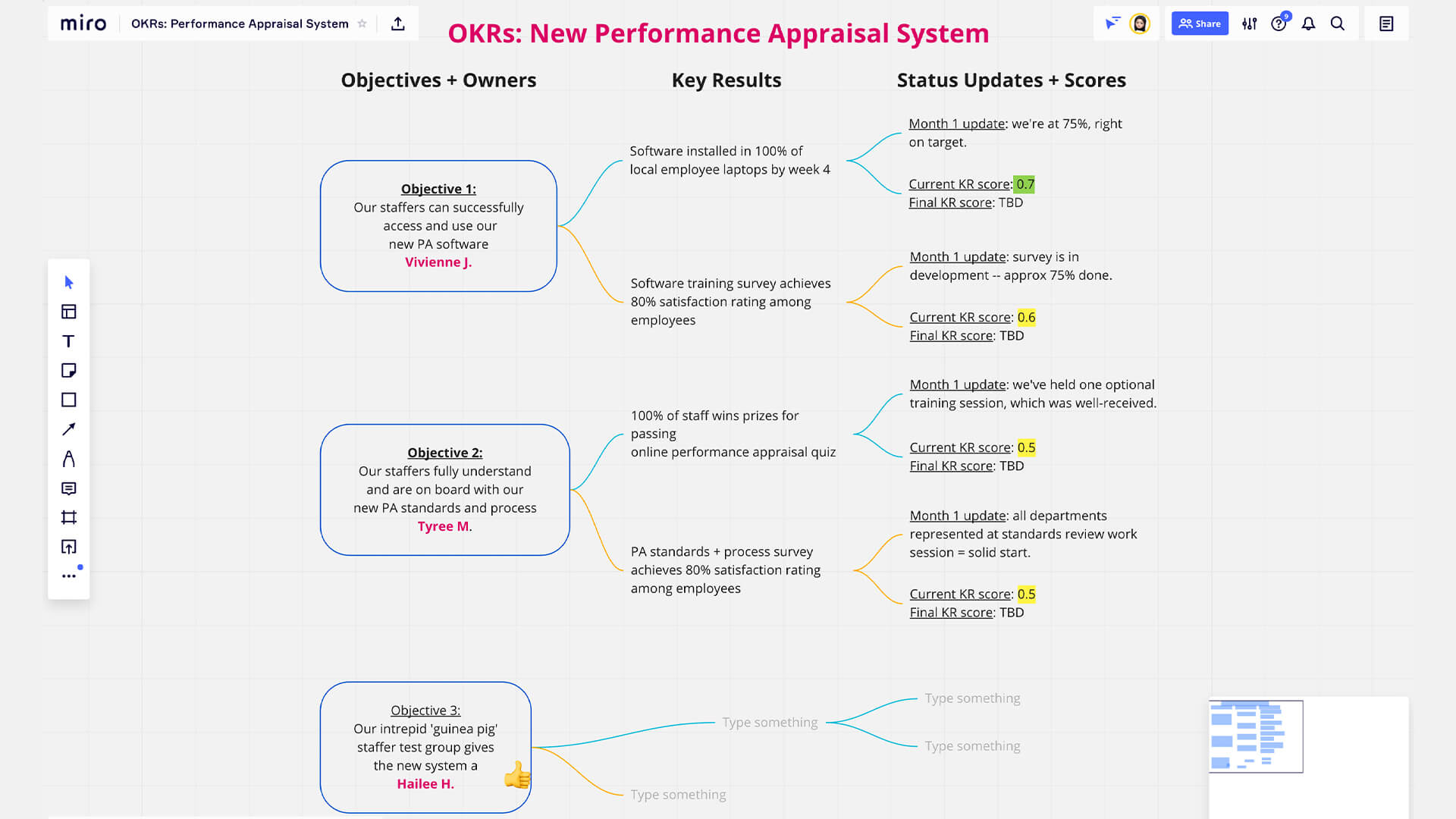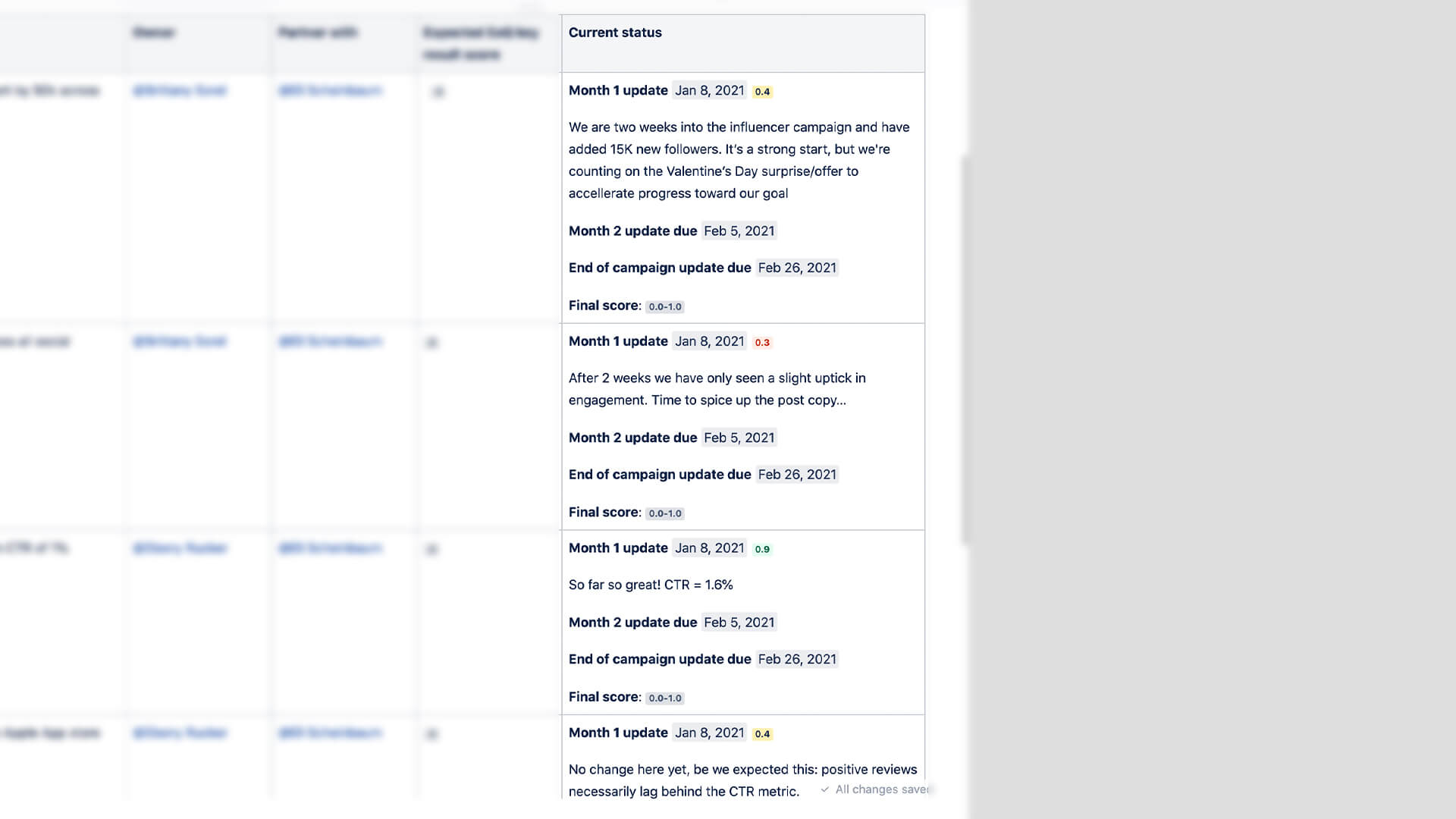Objectives and Key Results (OKRs)
Use the OKR goal-setting framework to define objectives, establish key results, and accelerate progress toward achieving your organizational and team goals.

PREP TIME
10m
Run TIME
2h
Persons
3-11
5-second summary
- Define 1-3 objectives.
- Set 3-5 key results per objective.
- Track success and score your OKRs each month.
WHAT YOU WILL NEED
- Video conferencing with screen sharing or meeting space.
- Digital collaboration tool (see templates).
- Timer.
PLAY resources
How to set OKRs
The OKR Play shares a five-step process that any team can follow to define objectives, articulate desired results, and track success with OKRs.
什么是目标和关键成果 (OKR)?
John Doerr 在他的《Measure What Matters》一书中介绍了 OKR,他把目标描述为“是什么”,把关键成果描述为“怎么做”。让我们进一步解释一下。
目标代表了您想要完成的事情,也表示方向或目的。它们通常是定性的、远大的,旨在激发行动。
关键成果详细说明了您将如何通过具体、可衡量的结果来实现目标。它们是定量的,跟踪实现目标的进度,通常有明确的指标或里程碑。
OKR 在整个组织内实施时最为有力,因为它们在团队和个人之间是阶梯式的。
为什么要开展 OKR 演练?
以下是开展 OKR 演练的两个有力理由:
- 确定什么是重要的:OKR 明确了什么是优先事项,以及您的工作如何为这些组织目标做出贡献。
- 确定什么是无关紧要的:OKR 明确了什么不是优先事项。它们使团队能够专注于一系列有限的优先事项,并拒绝那些分散核心工作精力的任务。
OKR 使团队围绕目标保持一致,提高透明度,鼓励问责制,并为衡量成功提供了一个清晰的框架。如果实施得当,OKR 可以推动整个组织的绩效和协作。
何时在工作中使用 OKR
在增长、变革时期或需要改进整个组织的透明度和问责制时,OKR 尤为有用。Atlassian 团队每年都会设定 OKR,每季度更新一次,并每月跟踪进度。
OKR 的 3 个优势
- 积极影响:83% 的调查参与者一致认为 OKR 已经并将继续对组织产生积极影响(《2022 年 OKR 影响报告》)。
- 更高的工作效率和目标实现率:确定工作优先顺序的团队提高效率和生产力的可能性提高了 4.6 倍(《Atlassian 2024 年团队状态报告》)。
- 敏捷性和适应性:OKR 能够迅速调整目标,帮助公司快速适应变化。通过确定首要目标使公司适应变化的可能性提高了 4.7 倍(《Atlassian 2024 年团队状态报告》)。
1. Prep the Play
1. 为剧本做准备 5 分钟
当您与团队开会时,无论是现场会议还是远程会议,都要发送一条消息来解释本演练及其开展原因。然后,创建协作文档,例如 Confluence 页面。您可以使用提供的模板或创建自己的模板。
作为一个团队,决定设定 OKR 的时间段(季度是一个好的开始),并在开展本演练之前分享以下信息:
- 更广泛的公司目标和目的
- 项目路线图
- 客户指标和/或反馈
-
如果有,以前的 OKR
提示:由上层引导
如果您的公司没有 OKR,那就去寻找他们想要重点关注的年度战略计划或最重要的事情。这些应该成为整个团队编写 OKR 的依据。
2. Define objectives
1. 为剧本做准备 5 分钟
让团队集思广益制定目标—他们希望在规定时间段内实现的目标。目标应该是定性的、远大的,是团队所有事项中的重中之重。
将想法添加到协作文档中。将相似的目标组合在一起,然后将想法总结为 1 至 3 个目标。
1. 提高客户满意度
2. 加快产品开发
3. 扩大市场覆盖面
4. 提高团队工作效率
5. 为未来而构建
6. 赢得人心
7. 成为一家人工智能公司
8. 提高优先产品的参与度
9. 扩大业务团队的采用率
10. 增加销售收入
3. Set key results
1. 为剧本做准备 5 分钟
让每个人在“职责(我的想法)”列中写下他们在此项目中的前 3-5 项职责。
1. 目标:提高客户满意度
- 关键成果 1:净推荐值 (NPS) 达到 50 或更高
- 关键成果 2:将客户咨询的平均回复时间缩短至 2 小时以内
-
关键成果 3:将客户留住率提高 10%
2. 目标:加快产品开发
- 关键成果 1:到第 4 季度末推出两项新功能
- 关键成果 2:将平均缺陷解决时间缩短 25%
-
关键成果 3:将自动化测试的百分比提高到 80%
3. 目标:扩大市场覆盖面
- 关键成果 1:年底前进入三个新的地区市场
- 关键成果 2:在目标市场将品牌知名度提高 20%
-
关键成果 3:与五个关键影响者或组织建立合作伙伴关系
提示:成果,不是任务
KR 是衡量工作的标准,而不是工作本身。
“创建 5 个网页”是工作。
“页面浏览量增加 5%”是一个关键成果。
提示:保障质量
确保 KR 同时捕捉输出和质量。例如,如果您的 KR 是已解决的帮助台请求单数量,那么您还可以衡量提交的请求单的减少情况,以确保帮助质量得以维持。其目标不是为了通过降低质量来实现 KR。
4. Assign owners
1. 为剧本做准备 5 分钟
对于确定的每个其他角色,在“职责(其他人的想法)”列中写下您对该角色的主要职责的理解。
如果您认为任何职责不明确属于某个角色,请将其添加到未分配的职责部分。
5. Tracking success with OKRs
1. 为剧本做准备 5 分钟
在“职责(其他人的想法)”列中查看其他人对您的角色写了什么。如果您接受每项职责,请打对号 ✅;如果您不接受,请打叉号 ❌。
如果您对其他人所写的职责有疑问或意见,请添加内联评论。
经过团队讨论之后,角色持有人查看带有 ❌ 的所有职责,并决定是承担还是委派额外的责任。如果任务重叠,应指定主要负责人以及潜在贡献者或后备负责人。
任何无人认领或无人接受的职责都会移至未分配的职责部分。
根据组织结构,角色持有人可能需要获得其领导层的批准,才能最终确定在此过程中列出的角色。
Follow-up
分享
与团队分享最终文档,以收集有关任何潜在差距或机会的反馈。
将角色和职责文档分发给主要利益相关者和领导者,并将此行动告知团队。
计划每隔三到六个月或者当团队内部发生重大变化时与团队一起回顾此剧本。定期练习会使此过程更顺利。

还有问题?
与其他 Atlassian 使用手册用户开始对话、获取支持或提供反馈。
Other plays you may like
决策制定
DACI 决策框架
分配明确的角色,确保决策过程中的有效协作和问责。
决策制定
权衡取舍
定义项目变量并确定其优先级。
Goal-setting
Modeling Strategic Focus Areas
Build and align on your organization’s strategic focus areas.
了解最新信息
注册我们的时事通讯,获取最新的演练和 工作生活建议。










